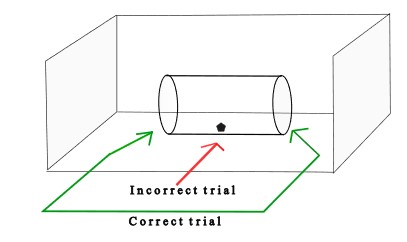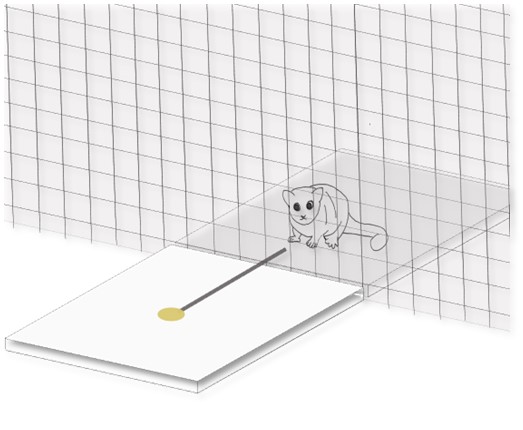I studied problem solving, inhibitory control and causal understanding in 34 captive grey mouse lemurs, of which were 16 males and 18 females. Due to their nocturnal activity, all experiments were performed under red light conditions.
In order to study the cognitive skills I mentioned before, I performed three types of tests:
Food extraction task
First, to study the problem solving skills I did a food extraction task. In this task, there was a box with a total of 12 compartments and 6 sliding doors. During the experiment, the sliding doors covered 6 of those compartments and in each one there was a piece of banana as a food reward. The individual then had to open the sliding doors to get access to the banana pieces.
During this test both the innovation speed (= time between first contact with the box and opening the first door), and the innovative propensity (= number of opened doors from 0-6) were measured.

Cylinder task
Secondly, to study the inhibitory control, I performed a cylinder task. During this task, the animal had to take a piece of banana out of a transparent cylinder. If the animal went into the cylinder to take the banana, without touching or sniffing the side of the cylinder first, this was scored as a correct trial. However, if the animal would first sniff or touch the side of the cylinder, this was scored as an incorrect trial. For each individual I conducted a total of 10 trials.
For this test, the number of incorrect trials was then recorded.

String-pulling task
Lastly, to study the causal understanding, I performed a string-pulling task. During the string-pulling task, there was one experimental platform on the inside of the cage that had the end of a string tie on it. Another platform on the outside of the cage supported the other end of the string with a small plate attached to it that carried a small slice of banana as food reward. The animal then had to pull the string to get the plate piece with the food reward into reach and thereby get access to the piece of banana.
During this test, the success latency (= time between first contact with the experimental platform and getting to the food reward) was recorded.
